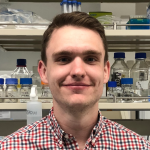
- Title Graduate student—Emili lab
- Education B.A. from Boston University
- Office Emili lab, K323
- Email mllawton@bu.edu
- Area of Interest T-cell signaling
Proteomics
I received my undergraduate degree from Boston University, where I also began my research career in Professor Bradham’s lab. There, I studied the effects of bioelectricity and ion gradients during development, using sea urchins as a model. During my time there, my interest in developmental biology grew, and after graduation worked as a technician and lab manager for the Ikonomou lab at the Center for Regenerative Medicine at the Boston University School of Medicine. Here, I was involved in lung development research, where we used mouse models to investigate lung specification from the foregut endoderm, as well as attempt to use information gleaned from that work to differentiate lung epithelium in vitro from stem cells, using both mouse embryonic and induced pluripotent stem cells. I was also involved in work attempting to derive craniofacial mesenchymal progenitor cells from human induced pluripotent stem cells, which could open up future possibilities for facial regeneration and reconstruction.
Initially, I applied to graduate schools looking for a developmental biology laboratory, but experience with a single cell sequencing project and some bioinformatics at the end of my time with Ikonomou lab pulled me in a different direction. I rotated a couple labs aimed more at using ‘omic technology platforms, the Spira/Lenburg lab, and then the Emili lab, where I am now.
My research interests are in exploring various aspects of T cell signaling using a proteomic/phosphoproteomic platform. Proteomics uses mass spectrometry methods for the unbiased, global interrogation of thousands of proteins from a single experiment, allowing for high-confidence quantitative data of protein expression. Phosphoproteomics, which is run in parallel in our proteomics pipeline, allows for the identification and quantification of tens of thousands of phosphorylation sites on thousands of proteins, which can give insight into both protein function and signaling pathway regulation. Using this technology, my interests are in studying T cell signaling in a few different lights; one interest, in collaboration with Wong Lab, is examining signaling differences in chimeric antigen receptor (CAR) T cells, which are synthetic receptors inserted into a patient’s T cells designed to recognize and eliminate cancer cells. CARs are designed to mimic a T cell activation response, but since these receptors are synthetic, signaling can be altered and cause unwanted effects. Another area is signaling in disease, such as Type II Diabetes, where patients often exhibit increased risk of infection and cancer, which may be caused in part by aberrant signaling in T cells. Lastly, I am also interested in T cell exhaustion, where T cells are exposed to too much antigen for too long, such as in a tumor environment or chronic infection, and become inert, no longer proliferating or performing their effector functions.
Publications
Ikonomou L, Herriges MJ, Lewandowski SL, Marsland R, Villacorta C, Caballero IS, Frank DB, Sanghrajka RM, Dame K, Kańduła MM, Hicks-Berthet J, Lawton ML, Christodoulou C, Fabian AJ, Kolaczyk E, Varelas X, Morrisey EE, Shannon JM, Mehta P, Kotton DN (2020) The In Vivo Genetic Program of Murine Primordial Lung Epithelial Progenitors. Nat Commun 11, 635. DOI: 10.1038/s41467-020-14348-3
Jamal M, Lewandowski SL, Lawton ML, Huang GT-J, Ikonomou L (2018) Derivation and characterization of putative craniofacial mesenchymal progenitor cells from human induced pluripotent stem cells. Stem Cell Res 33: 100-109. DOI: 1016/j.scr.2018.10.015
Schatzberg, D., Lawton, M., Hadyniak, S. E., Ross, E. J., Carney, T., Beane, W. S., & Bradham, C. A. (2015). H+/K+ ATPase activity is required for biomineralization in sea urchin embryos. Developmental biology, 406(2), 259-270.